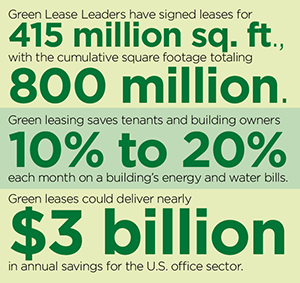“Green leasing” is becoming more common, with many major commercial property owners and managers embracing the concept—and being recognized for it.
Earlier this month, for instance, “Green Lease Leaders” were recognized by the U.S. Department of Energy at its Better Buildings Summit in Washington, D.C. The program was established by the DOE Better Buildings Alliance and the Institute for Market Transformation to acknowledge property owners, tenants and brokers who are effectively using green leases to drive energy and water savings in commercial buildings, which offers substantial benefits to both businesses and the environmental.
 So far this year, Green Lease Leaders have signed leases for 415 million sq. ft., with the cumulative square footage totaling 800 million.
So far this year, Green Lease Leaders have signed leases for 415 million sq. ft., with the cumulative square footage totaling 800 million.
A green lease encourages collaboration between landlords and tenants to take action to improve efficiency. On average, green leasing saves tenants and building owners 10 percent to 20 percent each month on a building’s energy and water bills. In fact, a study released by IMT this month shows that green leases could deliver nearly $3 billion in annual savings for the U.S. office sector alone.
San Francisco-based Shorenstein Properties was among this year’s recipients of the Green Lease Leader title. Since 2008, Shorenstein has been committed to sustainability on behalf of its properties, tenants, employees and local communities. Sustainability measures have reduced the company’s energy use by 16.2 percent and cut its carbon emissions by 14.8 percent. NREI spoke with Jonathan Salzberg, who is Shorenstein’s asset management associate, and Jaxon Love, the firm’s sustainability program director, about how green leases work.
NREI: How does a green lease differ from a regular lease?
Jonathan Salzberg: It includes specific provisions that address energy efficiency and building environmental performance. It’s not more complicated at all. There is very little difference, just a few key provisions that can have a big impact.
NREI: Can a building that’s not green have a green lease?
Jaxon Love: Yes. Green leasing is separate from LEED certification. The provisions support LEED certification, but are not a prerequisite.
NREI: Do tenants know and understand green leases? Are you finding that they expect them more often?
Jaxon Love: We have found that, in many cases, tenants aren’t familiar with green leasing. Larger tenants are more up to speed on these leasing provisions, but generally I’d say that it has been pretty quiet in terms of hearing from tenants about these specific provisions. It’s a little bit under the radar.
NREI: What are some of the lease provisions that are included to address barriers to resource conservation and pollution prevention?
Jonathan Salzberg: We met the award criteria based on having a minimum of four green lease clauses. Our five clauses are: Energy alignment, i.e., a cost-saving capital expenditures clause; tenant submetering, which we don’t do everywhere, but which we are advancing in those markets where leasing standards are amenable, and we are pushing it wherever we can; energy information sharing to meet the requirements of disclosure laws; building performance certifications, which is a tenant requirement to comply with LEED/Energy Star guidelines for certification of the building; and green building standards.
NREI: How have green lease provisions helped Shorenstein as a landlord, your tenants, and the environment?
Jaxon Love: It has allowed us to overcome some traditional barriers to energy efficiency. For example, we are submetering tenants in some of our recently redeveloped San Francisco properties, which gives the tenant direct responsibility for and control over their energy cost. The economic incentive to save energy is a powerful motivator.
Jonathan Salzberg: In cities where we have benchmarking—San Francisco; Washington, D.C.; New York City; Philadelphia; Boston; Minneapolis; Chicago; and Austin, Texas—the provisions give the landlord the authority to gather the necessary information from tenants, which is a critical prerequisite for regulatory compliance.
Jaxon Love: Green leasing makes sustainability part of the landlord/tenant relationship from the outset. Setting the tone at the beginning of the relationship should make conversations about environmental impact easier down the road.
NREI: Do you find that green leases, which are by their nature more collaborative, improve landlord-tenant relations?
Jonathan Salzberg: We find that green leases overcome barriers and create the right incentives for better collaboration on efficiency and environmental impact. Submetering is a perfect example, and our redevelopment projects in San Francisco highlight this. Tenant submetering is in both parties’ interests because it gives tenant direct control of operating expense and landlords end up with a more efficient asset.
NREI: How predominant are green leases with Shorenstein tenants?
Jaxon Love: We have been using green lease provisions for several years now. As of October 2014, we are using the provisions mentioned earlier in all leases nationally.
NREI: Shorenstein has been committed to sustainability since 2008. How did committing to green leases enhance or deepen that commitment?
Jaxon Love: Green leasing makes sustainability part of the landlord-and-tenant relationship from the outset. Setting the tone at the beginning of the relationship should make conversations about environmental impact easier down the road.
Jonathan Salzberg: Sustainability is a way of doing business. It’s not a separate task or stand-alone process. It’s integrated into all aspects of real estate operation. Leasing is a central part of our business operation and green leasing integrates sustainability into that business process.
NREI: Any final takeaways on green leases?
Jaxon Love: We survey our tenants annually on sustainability and track interest and satisfaction with our program. In 2014, 66 percent of our tenants indicated that green building operation is important or very important to their company; 68 percent of tenants indicated that our green building operation is good or excellent.
Jonathan Salzberg: As part of the recently passed Tenant Star legislation, the Government Services Administration will be considering green leasing requirements for federal leasing. We expect green lease provisions to become more commonplace in the market over the next few years.

